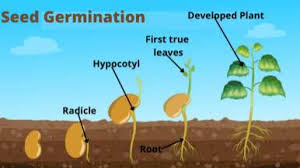Essential Factors Influencing Seed Germination Success
Seed germination is the transformative process through which a dormant seed awakens to become a young plant. In simple terms, what is seed germination? It is the journey from a tiny seed to a vibrant seedling, and understanding the seed germination process is essential for both students and gardening enthusiasts alike.
What is Seed Germination?
Seed germination refers to the natural process by which a seed emerges from dormancy and begins to grow into a plant. This journey starts with the sprouting of any seed is the visible emergence of a radicle (the primary root), followed by the growth of a plumule (the shoot). During this process, the seed’s internal physiology becomes active as enzymes are initiated and the stored food is metabolised.

Imbibition: Rapid water uptake that softens the seed coat.
Activation: Enzyme activation and metabolic reawakening.
Emergence: The radicle breaks through, followed by the shoot.
Growth: The seedling establishes and continues to grow.
Also Read: Formation of Seed
The Seed Germination Process in Detail

The seed germination process can be divided into distinct stages:
Imbibition:
When a seed comes into contact with water, it absorbs moisture rapidly. This hydration is crucial because it softens the seed coat, making it easier for the emerging root.
Why do seeds need water to germinate? Water acts as a solvent for essential nutrients and triggers the biochemical reactions necessary for growth.
Activation of Enzymes and Metabolic Processes:
As water permeates the seed, dormant enzymes become active. This stage marks the commencement of respiration and the conversion of stored food into energy.
This phase is vital as it sets the stage for cell elongation and division.
The emergence of the Radicle and Plumule:
The sprouting of any seed is symbolised by the radicle breaking through the softened seed coat. Soon after, the plumule (or shoot) begins to emerge.
A germination of seed diagram typically depicts this stage, showing how the radicle anchors the plant and the shoot grows upward in search of light.
Seedling Development:
Once the radicle is established, the seedling enters a period of rapid cell division and elongation. This growth phase eventually leads to the formation of leaves and the onset of photosynthesis.
Conditions and Factors Affecting Seed Germination
Successful seed germination depends on several key requirements:
Water: Water is critical because it softens the seed coat and activates enzymes. Many wonder, why do seeds need water to germinate? Simply put, water initiates the metabolic processes and nutrient mobilisation essential for growth.
Oxygen: Adequate oxygen is required for the vigorous respiration that fuels the seed germination process. Poor oxygen availability can hinder this process significantly.
Temperature: Most seeds require a moderate temperature—typically between 25°C and 30°C—for optimal germination. However, different seeds may have specific thermal needs.
Light or Darkness: Some seeds require exposure to light to trigger germination, while others germinate best in darkness. This environmental cue plays a vital role in the factors affecting seed germination.
Internal Factors:
Seed Dormancy: Some seeds possess dormancy mechanisms that delay germination until conditions are favourable.
Plant Hormones: Naturally occurring growth regulators can either inhibit or promote germination, adding an extra layer of complexity to the seed germination process.
Also Read: Dicotyledonous and Monocotyledonous Seed
In addition to the standard stages of seed germination, several unique aspects merit attention:
Enzymatic Control: Advanced research shows that the activation and inhibition of specific enzymes and hormones can determine the pace and success of germination.
Genetic Factors: Genetic predispositions influence not only the timing but also the robustness of the sprouting process.
Environmental Stressors: Conditions such as soil pH, nutrient availability, and microbial presence can subtly impact the factors affecting seed germination.
Fun Facts About Seed Germination
Tiny Beginnings: Some of the world’s largest trees begin their life from seeds so small that they could fit on a fingertip!
Dormancy Wonders: Certain seeds can remain dormant for decades until conditions are just right for germination.
Diverse Conditions: Seeds from desert plants have adapted to germinate rapidly after rare rainfalls, demonstrating nature’s remarkable resilience.
Real-World Applications
Understanding what is seed germination and its underlying processes has several practical applications:
Agriculture: Farmers utilise knowledge of the seed germination process to optimise crop yield by ensuring seeds are planted in ideal conditions.
Horticulture: Gardeners and botanists rely on controlled germination to cultivate ornamental plants and restore native flora.
Conservation: Seed banks and reforestation projects use germination techniques to revive endangered plant species.
Educational Tools: Germination of seed diagrams and interactive models are essential in biology classrooms to demonstrate plant growth.


FAQs on Seed Germination Explained: Process, Factors & Importance
1. What is seed germination?
Seed germination is the process by which a seed transforms into a young plant through a series of developmental stages.
2. What is the seed germination process?
It involves imbibition, enzyme activation, emergence of the radicle and plumule, and eventual seedling growth.
3. Why do seeds need water to germinate?
Water softens the seed coat, triggers enzyme activation, and mobilises stored nutrients necessary for growth.
4. How does temperature affect seed germination?
Moderate temperatures (typically 25–30°C) are ideal; too low or too high temperatures can slow down or inhibit the process.
5. Can light influence seed germination?
Yes, some seeds require light to germinate, while others prefer darkness as an environmental trigger.
6. What is a germination of seed diagram?
It is a visual representation of the stages of seed germination, showing the transition from seed to seedling.
7. What are the factors affecting seed germination?
Key factors include water availability, oxygen, temperature, light, and internal seed dormancy mechanisms.
8. How long does the seed germination process take?
The duration varies by species; some seeds sprout within days, while others may take weeks.
9. What internal factors can delay germination?
Dormancy due to an impermeable seed coat or the presence of growth inhibitors can delay the process.
10. How can the seed germination process be improved in agriculture?
By ensuring optimal water, temperature, oxygen, and light conditions, and by addressing internal dormancy issues, farmers can enhance crop yield.










